Fantasy Books
Half a Century of Reading Tolkien: Part Four – The Return of the King by JRR Tolkien
 A wild light came into Frodo’s eyes. ‘Stand away! Don’t touch me!’ he cried. ‘It is mine, I say. Be off!’ His hand strayed to his sword-hilt. But then quickly his voice changed. ‘No, no, Sam,’ he said sadly. ‘But you must understand. It is my burden, and no one else can bear it. It is too late now, Sam dear. You can’t help me in that way again. I am almost in its power now. I could not give it up, and if you tried to take it I should go mad.’
A wild light came into Frodo’s eyes. ‘Stand away! Don’t touch me!’ he cried. ‘It is mine, I say. Be off!’ His hand strayed to his sword-hilt. But then quickly his voice changed. ‘No, no, Sam,’ he said sadly. ‘But you must understand. It is my burden, and no one else can bear it. It is too late now, Sam dear. You can’t help me in that way again. I am almost in its power now. I could not give it up, and if you tried to take it I should go mad.’
Frodo to Sam in Mount Doom from The Return of the King
And so we come to the end of the first part of my return to JRR Tolkien’s work. For those not following along with my earlier essays (links at the bottom), inspired by a hate watch of Peter Jackson’s Lord of the Rings movies, I picked up The Fellowship of the Ring and quickly succumbed to a complete reread of the trilogy. As I set out to write an article about Fellowship, I instead, found myself realizing I’ve been reading the professor’s books for fifty years and how much they’d meant to me.
Last time, I wrote that when I was young, I tended to struggle through bits of The Two Towers. That was never the case with The Return of the King, something that I found to remain so on this reading. It’s got wilder and bigger battles than the previous book, incredible scenes (including one of the greatest in all three books and that Jackson insanely cut omitted from the theatrical release!), and Frodo’s and Sam’s journey becomes more desperate and its evocation of Christ-like self-sacrifice more potent. The penultimate chapter, The Scouring of the Shire, portrays the transformation wrought on the four hobbits by their undertakings. Finally, the book ends with one of my favorite closing lines of any book.
As usual, here’s let me give a brief synopsis for those who’ve yet to read The Lord of the Rings. The first half of the book, The War of the Ring, contains three narratives. Gandalf and Pippin set off for Minas Tirith while Merry rides with the Rohirrim, again, for Minas Tirith, but by a different route. Meanwhile, Legolas and Gimli follow Aragorn along the Paths of the Dead in search of supernatural allies.
Everyone comes together at Minas Tirith at various stages in the great siege of the city and the ensuant battle outside its wall. When Mordor’s forces are broken and scattered, under Aragorn’s command, an army is sent north to the Gates of Mordor with hopes of distracting Sauron’s unblinking eye from Frodo and Sam.
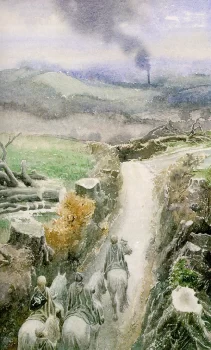 Homeward Bound by Alan Lee
Homeward Bound by Alan Lee
The End of the Third Age, the book’s second half, can be broken into several parts; the final leg of Frodo’s and Sam’s march to Mount Doom, the reunion of the surviving members of the Fellowship and Aragorn’s coronation, the scouring of the Shire, and a final farewell to Middle-earth. As with The Two Towers, this part of the trilogy evokes Tolkien’s wartime service, if not as in a direct way. On the one hand, both Merry and Pippin are transformed into hobbits of action and steel. There is nothing left that scares them. On the other, Frodo, never fully recovered from his wound on Weathertop, has been left drained and tired in the deepest parts of his soul by bearing the One Ring for so long, straight into the Enemy’s domain.
Each time around with LotR, I find myself noticing something new or being drawn with greater interest to a different part than previously. This time it was The Scouring of the Shire. I think, partially, it’s the better understanding that the fight against evil is never ending, and just as likely to happen in your own town as on some distant fields. More significantly, it was Frodo’s place in it. I remembered him as instrumental in the routing of Sharkey’s forces, but that is not the case at all.
When Frodo and Sam decide to lighten their load and ditch the orc gear weighing them down, Frodo makes an emphatic statement that “I’ll bear no weapon, fair or foul.” When it becomes clear that there are hobbits working for Sharkey and his ruffians, he issues an order:
“‘Fight?’ said Frodo. ‘Well, I suppose it may come to that. But remember: there is to be no slaying of hobbits, not even if they have gone over to the other side. Really gone over, I mean; not just obeying ruffians’ orders because they are frightened. No hobbit has ever killed another on purpose in the Shire, and it is not to begin now. And nobody is to be killed at all, if it can be helped. Keep your tempers and hold your hands to the last possible moment!’”
Pippin and Merry are ready to fight and do so when the time comes. Merry himself kills the leader of the ruffians. Frodo, though, doesn’t draw his sword and remains out of the battle. When it’s over, he steps in “to prevent the hobbits in their wrath at their losses, from slaying those of their enemies who threw down their weapons.”
Merry and Pippin prove themselves the highborn leaders they were always destined to be in the battle against the ruffians. It’s Frodo, though, after having suffered mightily and seen his share of death and destruction, who will have no more of it. I simply didn’t remember this aspect of Frodo. When we read that even the normally mild-mannered citizens of the Shire are pressing to kill their prisoners, it’s clear how different from them Frodo has become.
I understand Jackson omitting the scouring from his films. He’s had his big beat climax and the last chapter, wherein Frodo and several others exit the stage for good works well enough for a movie. What we lose, though, is the impact of learning that even the innocents of the Shire have been damaged by the war, and that even they can be driven to killing and murderous rage. In a land where presumably there’s never a murder, they suddenly have nearly a hundred corpses on their hands.
We also miss out that the once mighty Saruman, now reduced to a pitiful state, has become petty and spiteful. When finally confronted by the hobbits he revels in what he’s done to the Shire.
I have already done much that you will find it hard to mend or undo in your lives. And it will be pleasant to think of that and set it against my injuries.’
Despite many hobbits calling out to kill Saruman, Frodo only dismisses him with a sense of pity, largely for the noble being he once was. He even offers temporary sanctuary to Grima and the chance to escape his master’s control. From the beginning, Frodo is portrayed as a good person, but surviving the burden of the Ring seems to have turned into an outright noble one, something I don’t think I’ve tracked as closely before.
In the last few years, especially, it seemed, after the movies came out, there was a lot of talk that Sam Gamgee was the real hero of LotR. After this read, I think I’ve come around to that. Frodo sets out to take the Ring to Mount Doom, always with a sense of fatalism. His ownership of the Ring makes him feel obligated to take it to the end and he never has any doubts about what needs to be done.
Sam, however, chooses to go out of loyalty to Frodo, not for any sense of obligation to destroy the Ring. That does come upon him later when he thinks Frodo dead. He is the one tempted along the way, first by the visions in the Mirror of Galadriel and later by the Ring itself. He hesitates for a moment each time, but doesn’t falter. In fact, he is the only person we ever read of in the books or the appendices who gives up the Ring willingly. In a scene Jackson left out, Sam is tested and proved strong.
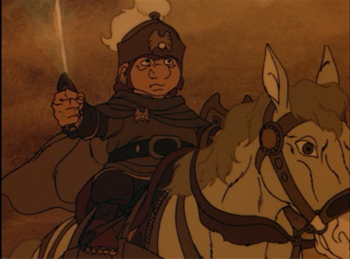 Samwise the Strong from Rankin and Bass
Samwise the Strong from Rankin and Bass
His thought turned to the Ring, but there was no comfort there, only dread and danger. No sooner had he come in sight of Mount Doom, burning far away, than he was aware of a change in his burden. As it drew near the great furnaces where, in the deeps of time, it had been shaped and forged, the Ring’s power grew, and it became more fell, untameable save by some mighty will. As Sam stood there, even though the Ring was not on him but hanging by its chain about his neck, he felt himself enlarged, as if he were robed in a huge distorted shadow of himself, a vast and ominous threat halted upon the walls of Mordor. He felt that he had from now on only two choices: to forbear the Ring, though it would torment him; or to claim it, and challenge the Power that sat in its dark hold beyond the valley of shadows. Already the Ring tempted him, gnawing at his will and reason. Wild fantasies arose in his mind; and he saw Samwise the Strong, Hero of the Age, striding with a flaming sword across the darkened land, and armies flocking to his call as he marched to the overthrow of Barad-dûr. And then all the clouds rolled away, and the white sun shone, and at his command the vale of Gorgoroth became a garden of flowers and trees and brought forth fruit. He had only to put on the Ring and claim it for his own, and all this could be.
In that hour of trial it was the love of his master that helped most to hold him firm; but also deep down in him lived still unconquered his plain hobbit-sense: he knew in the core of his heart that he was not large enough to bear such a burden, even if such visions were not a mere cheat to betray him. The one small garden of a free gardener was all his need and due, not a garden swollen to a realm; his own hands to use, not the hands of others to command.
Sam is the reason Frodo succeeds in reaching the furnace at Mount Doom. He rescues him from Cirith Ungol and later he carries him up the slopes of the volcano. He also matures along the journey. Several times in The Two Towers he is set to kill Smeagol. When given the chance to kill him again in this book, Sam finds himself unable to. Even though his time with the Ring was short, it has taught him much.
 Mount Doom by John Howe
Mount Doom by John Howe
‘Now!’ said Sam. ‘At last I can deal with you!’ He leaped forward with drawn blade ready for battle. But Gollum did not spring. He fell flat upon the ground and whimpered.
‘Don’t kill us,’ he wept. ‘Don’t hurt us with nassty cruel steel! Let us live, yes, live just a little longer. Lost lost! We’re lost. And when Precious goes we’ll die, yes, die into the dust.’ He clawed up the ashes of the path with his long fleshless fingers. ‘Dusst!’ he hissed.
Sam’s hand wavered. His mind was hot with wrath and the memory of evil. It would be just to slay this treacherous, murderous creature, just and many times deserved; and also it seemed the only safe thing to do. But deep in his heart there was something that restrained him: he could not strike this thing lying in the dust, forlorn, ruinous, utterly wretched. He himself, though only for a little while, had borne the Ring, and now dimly he guessed the agony of Gollum’s shrivelled mind and body, enslaved to that Ring, unable to find peace or relief ever in life again. But Sam had no words to express what he felt.
‘Oh, curse you, you stinking thing!’ he said. ‘Go away! Be off! I don’t trust you, not as far as I could kick you; but be off. Or I shall hurt you, yes, with nasty cruel steel.’
Could Sam have carried the Ring himself to Mount Doom himself, probably not. But Frodo, for all his spiritual resilience, fails in the end. Only with Sam’s help could he have even made it to that point. Tolkien himself referred to Sam as the “chief hero,” so I guess I’ll have to go along with that.
Which leads me to Peter Jackson’s version. Instead of Frodo overwhelming Smeagol and dominating him by the power of the Ring. Which means we miss this:
‘Down, down!’ he gasped, clutching his hand to his breast, so that beneath the cover of his leather shirt he clasped the Ring. ‘Down, you creeping thing, and out of my path! Your time is at an end. You cannot betray me or slay me now.’
Then suddenly, as before under the eaves of the Emyn Muil, Sam saw these two rivals with other vision. A crouching shape, scarcely more than the shadow of a living thing, a creature now wholly ruined and defeated, yet filled with a hideous lust and rage; and before it stood stern, untouchable now by pity, a figure robed in white, but at its breast it held a wheel of fire. Out of the fire there spoke a commanding voice.
‘Begone, and trouble me no more! If you touch me ever again, you shall be cast yourself into the Fire of Doom.’
Instead of Sam refraining from killing him as described above, there’s a short, vicious encounter that ends with Sam cutting Smeagol in the belly. It continues Jackson’s rejection of nuance and complication for action every time.
There are so many problems I have with the movie. Two-trunked titanic oliphaunts that Legolas parkours on, well, they’re bad. Worst of all is the denigration of Denethor. Tolkien’s character is a man of great learning who has been lured into despair by his contact with Sauron. A once noble man has fallen into such hopelessness that he can’t even imagine there’s any chance of survival. Instead, Jackson gives us a snide, snarling man who makes Pippin sing for him while he devours food like an animal, juices dribbling down his face. Again, nuance of character has no place.
One thing that particularly stands out is the elimination of, what’s for me, one of the most iconic moments in The Return of the King. When the great gate of Minas Tirith is broken down, Gandalf confronts the Witch King. That Jackson chose to make up his own scenes and dialogue for the movies but excised this one, well, it’s inexcusable.
 Witch King at the Gate by Angus McBride
Witch King at the Gate by Angus McBride
Thrice he cried. Thrice the great ram boomed. And suddenly upon the last stroke the Gate of Gondor broke. As if stricken by some blasting spell it burst asunder: there was a flash of searing lightning, and the doors tumbled in riven fragments to the ground.
In rode the Lord of the Nazgûl. A great black shape against the fires beyond he loomed up, grown to a vast menace of despair. In rode the Lord of the Nazgûl, under the archway that no enemy ever yet had passed, and all fled before his face.
All save one. There waiting, silent and still in the space before the Gate, sat Gandalf upon Shadowfax: Shadowfax who alone among the free horses of the earth endured the terror, unmoving, steadfast as a graven image in Rath Dínen.
‘You cannot enter here,’ said Gandalf, and the huge shadow halted. ‘Go back to the abyss prepared for you! Go back! Fall into the nothingness that awaits you and your Master. Go!’
The Black Rider flung back his hood, and behold! he had a kingly crown; and yet upon no head visible was it set. The red fires shone between it and the mantled shoulders vast and dark. From a mouth unseen there came a deadly laughter.
‘Old fool!’ he said. ‘Old fool! This is my hour. Do you not know Death when you see it? Die now and curse in vain!’ And with that he lifted high his sword and flames ran down the blade.
Gandalf did not move. And in that very moment, away behind in some courtyard of the City, a cock crowed. Shrill and clear he crowed, recking nothing of wizardry or war, welcoming only the morning that in the sky far above the shadows of death was coming with the dawn.
How do you decide to introduce those ridiculous looking oliphaunts but leave this out? Who the heck knows. To me, it seems like a terrible appreciation for what’s really cool and awesome. That said, the charge of the Rohirrim and the death of the Witch King are pretty solid.
In the beginning, I came to The Lord of the Rings just as the sequels to The Hobbit. Gradually, I understood they had something to say, artistically and thematically. Gradually, the complex architecture of the books and the characters became clearer. This time around, I think the tragic elements have resonated the most — the fallen state of Middle-earth, Boromir’s and his father’s fates, Smeagol’s, too, of course, and, ultimately, Frodo’s. By the last pages, all the magic has flowed out of Middle-earth and its fate is in the hands of men.
I really don’t know how many times I’ve read these books. There was a period where I read them every year or two. Nonetheless, each time I come back to them, it’s almost like I’m reading them for the first time. I’ve read my share of ridiculously big epic fantasies, but none of them have really earned their length in the way these books have. I can’t say when, but I will be rereading them sooner rather than later.
So, what’s next? I’m not sure. My plans include reading The Hobbit, The Silmarillion, and definitely Bored of the Rings. I might finally crack open my copies of The Fall of Gondolin and Beren and Luthien, too. I hope you’re willing to follow me along.
Gandalf and the Witch King from Rankin and Bass’ The Return of the King
Half a Century of Reading Tolkien: Part One
Half a Century of Reading Tolkien: Part Two – The Fellowship of the Ring by JRR Tolkien
Half a Century of Reading Tolkien: Part Three — The Two Towers by JRR Tolkien
Fletcher Vredenburgh writes a column each first Sunday of the month at Black Gate, mostly about older books he hasn’t read before. He also posts at his own site, Stuff I Like when his muse hits him
Book Review: The Staircase in the Woods by Chuck Wendig
I received a review copy from the publisher. This does not affect the contents of my review and all opinions are my own.
 The Staircase in the Woods by Chuck Wendig
The Staircase in the Woods by Chuck Wendig
Mogsy’s Rating: 3.5 of 5 stars
Genre: Horror
Series: Stand Alone
Publisher: Del Rey (April 29, 2025)
Length: 400 pages
Author Information: Website
I rarely miss picking up a new Chuck Wendig book, which is why I really wanted to love The Staircase in the Woods. I guess in some ways, I did—but it also took me way longer to finish than I expected. Despite a strong beginning and end, I found myself bogged down by the middle section which felt repetitive and a bit bloated, slowing down momentum.
Still, there’s no denying this book has one hell of a killer premise! It features a group of teenagers—Owen, Lore, Matty, Hamish, and Nick—who experience a supernatural tragedy one summer, reuniting decades later to confront the truth of what really happened. It all began in high school, when during one of their usual hangouts in the woods, the five friends stumble upon a strange spiral staircase rising out of the ground and leading to nowhere. One fateful night, buzzed on booze and bravado, Matty decides he wants to climb it—and he’ll even do it by himself, if the others are too chicken. Only, upon ascending, he vanishes without a trace. The rest of the group is left traumatized and grief-stricken, blamed by the community for their friend’s disappearance. Shattered by guilt and unanswered questions, they eventually graduate and go their separate ways.
Twenty years later, however, Nick reaches out to the others with dire news and a request: first, he has terminal cancer, and second, he wants to find out what happened to Matty. Reluctant but unable to refuse their dying friend, Lore, Owen, and Hamish agree to meet. They learn that Nick has found the damned staircase again, and this time when he leads them to it, they all make the climb. But the mystery of what befell Matty isn’t going to be solved so easily. In fact, things get weird fast. The friends find themselves inside a house that shouldn’t exist, a surreal place where each room forces them to face their deepest fears and relive their worst memories. They soon realize the house is playing with them, feeding off their pain. And while they have come to find Matty, it’s uncertain now whether any of them will make it out alive.
I’ll start with the positives. The supernatural elements in The Staircase in the Woods are certainly effective when it comes to the chill factor, even more so when I learned from the author’s note that he drew inspiration from real reports of mysterious staircases found in the middle of wooded areas, including one he personally encountered. While many of these sightings turn out to have perfectly rational and mundane explanations—like remnants of old photography and hunting platforms, or abandoned houses where the rest of the structure has fallen around the staircase and long since been reclaimed by nature—the idea still struck me as creepy. After all, the imagery itself is rather unsettling, making it easy to imagine other uncanny possibilities.
Clearly, much of the novel was also driven by tensions between the characters, a result of all their psychological and emotional baggage. As the saying goes, you can run but you can’t hide, and no matter how hard they’ve tried, none of the remaining four friends can move on from what happened to Matty. Even after achieving moderate success as a game designer, Lore remains deeply unhappy and feels victimized by everyone around her (and some of her political rants can be a bit much). Owen is a nervous wreck, and his anxiety has only worsened since his high school days. Hamish, the only one married with children, is nonetheless unsatisfied and self-destructive. And although Nick may act like a clown, the humor is merely a mask that hides the true desperation within him. To be honest, none of them are particularly likeable, but they are complex and feel genuine. I loved reading about their relationships in the past and in the present, and the most rewarding part was seeing how these connections are broken and healed again.
But now for the not-so-great. Like I said, not everything worked for me, particularly the story’s pacing. While it was smooth sailing for most of the first half, soon after, the plot started spinning its wheels. The characters end up splitting up, spending a long time moving through this house of horrors, with each room throwing more and more terrible things at them until these scenes begin to lose all meaning. At some point, it all feels done for the sake of shock value. The scares also blur together and become more of the same old, same old. I definitely struggled to get through this middle section, putting the book down multiple times then finding it hard to motivate myself to pick it back up again.
That said, picking it back up again I did, and I’m glad. Once the holding pattern finally breaks, the plot gets right back down to business, pushing forward rather than lingering in its own sluggish atmosphere. The payoff at the end of the book was well worth the wait, and the story’s resolution tied its themes of friendship, grief, and recovery back to the way things were for the characters before Matty’s disappearance tore them apart. Needless to say, I was happy with the conclusion, which was both satisfying and touching.
Despite my misgivings into its pacing issues, I would still recommend The Staircase in the Woods, especially if you enjoy stories about unexplained mysteries, haunted forests, and reunions between even more haunted friends. Admittedly, this one took a bit of a climb for me, but in the end there was still plenty to like.
![]()
![]()
Tubi Dive, Part IV
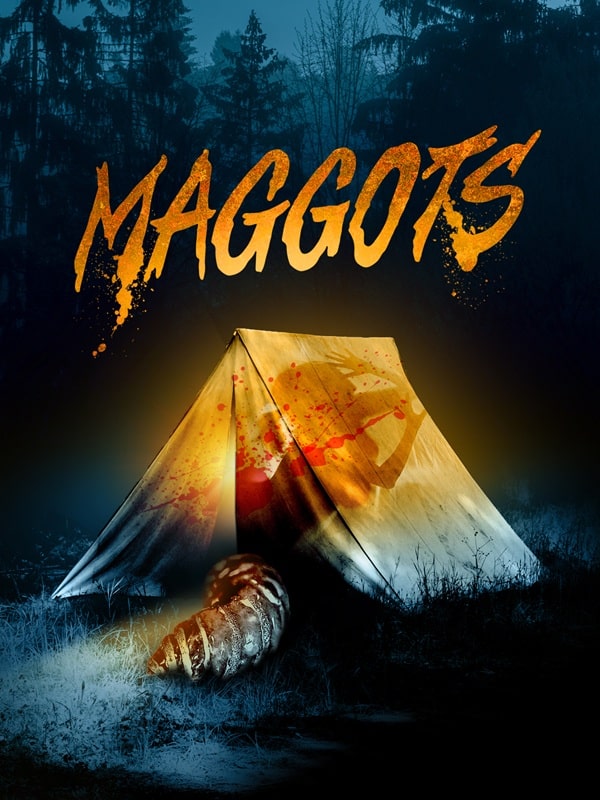 Maggots (JO JO New Media, 2017)
Maggots (JO JO New Media, 2017)
50 films that I dug up on Tubi.
Enjoy!
Maggots (2017)Despite usually taking the piss out of bad movies, I do have respect for filmmakers that actually complete them and get them seen. This brings us to Maggots — a horror/comedy that gets a couple of things right, and a lot wrong, but again I just can’t get mad at it.
The premise is simple; evil corporation dumping toxic sludge after fracking, bugs get mutated, bunch of disposables go camping.
The good stuff: the lead (Lawrence George) is good in his role as a nerdy science student who wants to expose the evil corporation, and the maggots are a lot of fun. They really reminded me of the Deadly Spawn, or naked Crites (from Critters). They are for the most part practical rubber effects, looking like fleshy windsocks with teeth.
The bad stuff: the script is terrible, and the acting goes from soulless mumble to shout. The director obviously thought one of his actors was hilarious, because we are subjected to his garbled nonsense throughout (this is comedy). We are told at the beginning of the film that his character suffers from ‘Sarcastic Tourette’s’ — so I guess I’m supposed to feel bad for disliking his banal schtick.
Anyhoo, we have the nerd, a tough female, a female willing to get her top bollocks out, a jock and a weirdo, along with a randy college professor and a pair of inept forest rangers, so the trope box is thoroughly ticked.
Honestly, I finished this one wanting to enjoy it more, and I can’t help thinking that if it had been played straight, and kept the goofy maggot puppets, this would have been a banger.
Fun fact — I gave it a higher rating than Rebel Moon on Letterboxd.
4/10
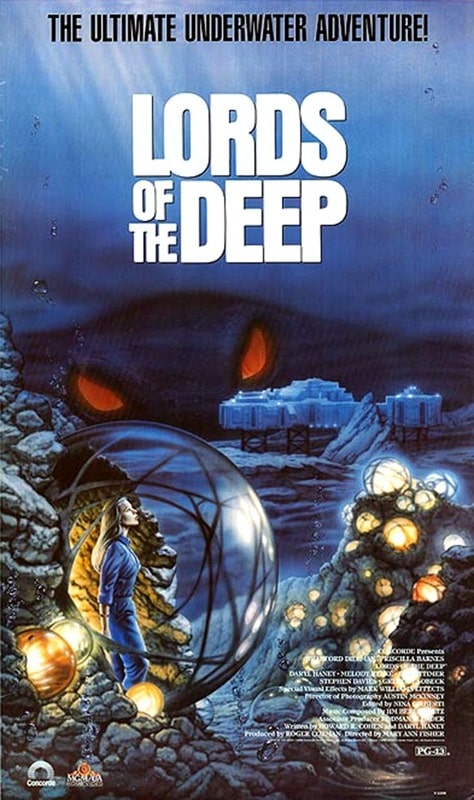

Lords of the Deep (Concorde Pictures, April 21, 1989) and Arena (Empire Pictures, March 29, 1989)
Fancied some cheap-looking rubbish, and luckily Tubi has an extensive Roger Corman collection.
It is the future, and once again we have messed up the planet. Therefore humanity has turned to the depths for somewhere new to screw up, and we hang with the crew of an exploratory vessel as they look for something or other. Lots of blue jumpsuits and sparsely decorated corridors ensue, before it all goes a bit Abyss, and the aliens start doing their thang. The undersea aliens messed up their own world and are here to tell us, in condescending Gort fashion, to stop our shenanigans. The aliens, a cross between a badly-folded fitted sheet and a flip-flop, are actually nice — so why are crew members dying? Could it be something to do with shifty-looking Bradford Dillman? You’ll never guess.
Fun fact: while reading up about this flick, I learned that two-time Oscar winner Janusz Kamiński was the DP, but was fired for being too good. Roger also cameos in this, but then he cameos in everything, bless him.
All in all, a bit pants.
3/10
Arena (1989)I wanted to chase the previous slice of Corman bunkum with one of his would-be heirs, and Charles Band has always been a reliable option. Empire Entertainment was catnip to weirdos like me in the 80s and yet, to my shame, I never got around to seeing Arena.
Well, I’ve fixed that oversight, and I’m jolly glad I did.
Empire is the company that churned out a ton of cheapo gore fests, normally with an incredibly daft premise, including beloved classics such as Ghoulies, Terrorvision, and Troll — and also produced stone-cold classics such as Trancers, Re-Animator and From Beyond.
Charles must have had decent cash flow going on, because he threw a bunch at this film — the production design is pretty good and the film is chockablock with prosthetics, animatronic beasties and derpy background artists. That said, one fun activity to do while watching is to count the mannequins in the medium crowd shots and the wiggling Q-tips in the wide shots. It’s all good though — clever mattes and inspired shot choices really pull this film together.
The story is about the heroically-named Steve Armstrong, a short-order cook who is handy with his fists. He ends up on the fighting circuit, and has the chance to be the first human in a long time to be champ. It’s all very Rocky, but everyone gives it their all, from Paul Satterfield as Steve, to Claudia Christian as his ‘owner’, Quinn. There’s a fun turn by Armin Shimerman under a couple of pounds of rodent rubber, playing a scummy henchman called Weezil, and Hamilton Camp playing a four-armed Nebulan called Shorty.
It’s all very silly, the actual fights are hilariously great and Richard Band’s music is on point. I had a fun time.
7/10

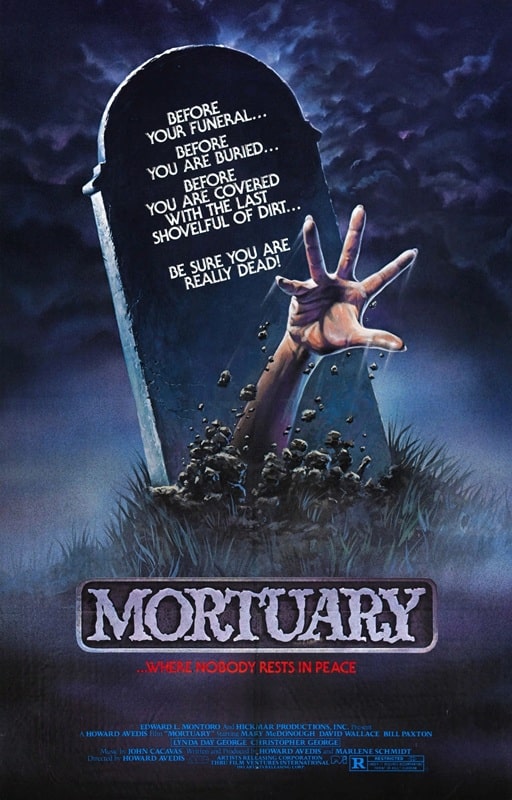
Zombie Ass: Toilet of the Dead (Nikkatsu, September 24, 2011)
and Mortuary (Film Ventures International, May 7, 1982)
This is the 25th review in our Tubi Dive, and we celebrate the quarter-century mark with quite possibly the most bonkers, disgusting, and hilarious film so far.
I’ve been a fan of Noboru Iguchi ever since I sat down to watch Machine Girl featuring the mind-blowing special effects of Yoshihiro Nishimura (who went on to direct Tokyo Gore Police), so imagine my delight when I stumbled upon a small collection of his films on Tubi. I’m going to watch them all — and I’ve started with this insanely offensive film.
Traumatized by the death of her sister, karate student Megumi has agreed to go on a camping trip with the usual group of stereotypes. One of her companions, Maki, is a self-absorbed would-be model, and her goal is to find a parasite in a fish, swallow it, and lose weight (not that she needed to). She succeeds, but the resulting tummy rumbles have her rushing to a disgusting outhouse in an abandoned village.
As she pops a squat to clear her bowels, she is attacked from below by a crap-coated zombie and, you guessed it, shenanigans ensue. What follows is some of the most ridiculous, stomach-churning, gory, and childishly fun action scenes you’ll ever see. Iguchi clearly couldn’t give a monkey’s about what anyone thinks of his films, and sets out to have a blast (no doubt satisfying some of his more ‘unsavoury’ tastes) by lacing the film with so many off-the-wall moments, homages to The Evil Dead, unnecessary nudity, hundreds of poop and fart gags, and sexually-charged monster attacks that border on live action anime.
Some shots are poorly done CG, but for the most part the creature and gore effects are practical and messy. I feel like my hyperbole might be getting in the way, but I seriously had such a fun time with this one — and I honestly can’t recommend it to decent folk.
For fans of poop, farts, blood and knickers.
9/10
Mortuary (1982)Just had time to sneak in another old slasher before I carry on with more Japanese nuttiness, and here’s an old chestnut that tries to elevate the slasher genre with zero success.
Christie believes that her father’s drowning was no accident (it wasn’t), but no one believes her; not her red herring of a mother, nor her chad of a boyfriend. Eventually the truth is revealed, but not before some dull stuff happens. Mortuary has all the trappings of a typical slasher (group of friends, creepy backstory, ‘masked’ killer, unusual weapon) but doesn’t follow through on any of them. A shame really, as it could have been a decent romp. It does get bonus points though for featuring an adorable young Bill Paxton.
For completists only.
4/10


Dead Sushi (Alchemy/Millennium, 2012) and Tomie Unlimited (Toei Company, May 14, 2011)
Next on my Noboru Iguchi-thon is this diamond-encrusted slice of fried gold in video form. As equally bonkers as Zombie Ass, I didn’t enjoy this one quite as much, but don’t let that stop you from taking in this unique form of high culture.
In a nutshell (or seaweed cone), Keiko is the daughter of a famous sushi chef, but when she doesn’t measure up to his standards, she runs away to work as a hostess at a crummy inn. There she becomes embroiled in a surreal revenge story involving chemicals, dodgy sushi and dodgier businessmen.
Imagine for a moment how weird this film could possibly be. You’re dead wrong. It’s much weirder. In fact, one of the less weird moments is a tender scene between a girl and a slice of cooked egg.
Noboru really reminds me of Joe Dante, when Dante is on a live-action Looney Tunes kick (see Gremlins 2 or Twilight Zone), but with much less logic and much more in the way of farting and bosom fetishism.
Utterly stupid, and a whole heap of fun — the opening fight scene alone is worth your time. Watch it, you fools.
7/10
Tomie Unlimited (2011)The Noboru-thon continues with his take on the classic manga series created by Junji Ito. In the graphic novels (and 9 film adaptations), Tomie is portrayed as a demonic force; sometimes a succubus, other times a vengeful spirit, but always she is the catalyst for much screaming, stabbing and head-scratching.
Noboru Iguchi, being a big fan of rubber puppets, really leans into the body horror and has a whale of a time, even if the film is slightly more serious in tone than Dead Sushi or Toilet of the Dead.
There are some astonishingly weird scenes (almost House weird) on offer, with just a few moments marred by dodgy CG. On the whole though, it’s creepy, disgusting, and sublimely daft. Tomie is played really well by Miu Nakamara — she is all angular cheekbones and lacerating looks, and Moe Arai is perfectly cast as her put-upon younger sister. She’s Phoebe Cates adorable, and it is particularly rough to watch her being hurt both physically and mentally.
Not the best of the Tomie films, but certainly worth a look.
7/10
Previous Murkey Movie surveys from Neil Baker include:
Tubi Dive, Part I
Tubi Dive, Part II
Tubi Dive, Part III
What Possessed You?
Fan of the Cave Bear
There, Wolves
What a Croc
Prehistrionics
Jumping the Shark
Alien Overlords
Biggus Footus
I Like Big Bugs and I Cannot Lie
The Weird, Weird West
Warrior Women Watch-a-thon
Neil Baker’s last article for us was Part III of Tubi Dive. Neil spends his days watching dodgy movies, most of them terrible, in the hope that you might be inspired to watch them too. He is often asked why he doesn’t watch ‘proper’ films, and he honestly doesn’t have a good answer. He is an author, illustrator, teacher, and sculptor of turtle exhibits. (AprilMoonBooks.com).
Camelot Fantasy Novels | 6 Paths of Hope, Courage, Fairness and Justice
Camelot fantasy novels have always held a special place in our hearts, representing reading that…
The post Camelot Fantasy Novels | 6 Paths of Hope, Courage, Fairness and Justice appeared first on LitStack.
THE DEVILS by Joe Abercrombie
Tor Doubles #4: Samuel R. Delany’s The Star Pit and John Varley’s Tango Charlie and Foxtrot Romeo
 Cover for The Star Pit by Tony Roberts
Cover for The Star Pit by Tony RobertsCover for Tango Charlie and Foxtrot Romeo by David Lee Anderson
Originally published in January 1989, the fourth Tor Double included John Varley’s Tango Charlie and Foxtrot Romeo and Samuel R. Delany’s The Star Pit. Printed in the a tête-bêche format, David Lee Anderson provided the cover by Tango Charlie and Foxtrot Romeo and Tony Roberts was the artist for The Star Pit.
The Star Pit was originally published in Worlds of Tomorrow in February, 1967. It was nominated for the Hugo Award. It lost to Philip José Farmer’s “Riders of the Purple Wage” and Anne McCaffrey’s “Weyr Search,” which tied each other. Coincidentally, McCaffrey and Delany share a birthday.
Vyme, a mechanic at the titular Star Pit, serves as Delany’s narrator. Rather than start with the present day action, however, Vyme opens his narration with memories of his own childhood and his life from several years earlier. Born on the backwater Earth in New York, he talks about his childhood and the ant farm he had as a child, which would eventually break.
He also talks about his life after leaving earth participating in a procreation group, a futuristic group marriage which was meant to make child rearing easier for both parents and children. Mostly talking about his kid-boy Antoni, who had an ecologarium, a sort of ant farm on a larger scale, it is clear that at best, Vyme is an absentee father, using the structure of the procreation group to allow himself to travel off world to take jobs as a mechanic and nursing his alcoholism, which eventually leads to him abandoning his group marriage.
Eventually, Vyme sobers up, but not before he can no longer return to his group family. Instead, he is on a Star Pit, a way station in space which is used to dock and repair spaceships. He is aided in this by Sandy and a young prodigy, Ratlit, who at thirteen has written a novel despite being functionally illiterate. Ratlit also helps out Alegra, a drug-addicted girl two years older than he is.
Vyme, Ratlit, Sandy, and Alegra are living their lives on the Star Pit in a world which has significant space travel, but in order for it to happen, people need to be identified as “the golden,” individuals who can pilot starships and are the only ones who can travel beyond the galactic plane without going insane, although their sanity is in question in any event.
According the Vyme, the golden are stupid and mean and the details of his interactions with them certainly bear that out, as well as a certain pettiness and a parallel society which normal humans can only watch and not fully understand. When one golden kills another in Vyme’s shop, Vyme and Sandy take it in stride. The surviving golden claims ownership of the dead golden’s ship and, not wanting it, hands it over to Sandy.
The plot of The Star Pit, such as it is, is secondary to the characters and their relationships with each other. Despite Vyme’s paternal tendencies toward Ratlit and his mentoring of Sandy, or Ratlit taking care of Alegra and making sure she is being treated for her illnesses, none of the characters seem to particularly like each other. They have been thrown together by circumstances and deal with each other as best that can.
While Vyme presents his background at the beginning of the novella, the other characters’ stories are only slowly revealed, and, while Vyme is not necessarily an unreliable narrator, the explanation for Sandy, Ratlit, Alegra, and, eventually the young golden Androcles, are all viewed through Vyme’s point of view. When Androcles show sup looking for a job, it is clear that Vyme sees him, at least in part, as a surrogate for his own long lost son, Antoni.
There is a certain disjointedness to The Star Pit, perhaps representing the fact that Vyme is not entirely comfortable with his own position and the difficult relationships he has with Sandy and Ratlit, one of whom appears to represent his own failures and the other of whom represents the possibilities a young Vyme drank away and squandered.
The Star Pit postulates a galaxy in which humans have spread, but its tight focus makes the galaxy feel like a very small place. While the golden have the ability to travel, most humans are limited as to where they can go, which is a response and reaction to all the stories of galactic empires and humanity expanding throughout the galaxy and universe.
Rich Horton discussed The Star Pit in the essay “An Evocation of the Science Fiction Dream of Exploration: ‘The Star Pit’ by Samuel R. Delany” in Black Gate in December 2020.
 Worlds of Tomorrow 2/67 cover by Gray Morrow
Worlds of Tomorrow 2/67 cover by Gray MorrowBlue Champaign cover by Todd Cameron Hamilton
Tango Charlie and Foxtrot Romeo was originally published in the John Varley collection Blue Champagne by Dark Harvest Press in January, 1986. It won the Seiun Award in 1992.
Tango Charlie and Foxtrot Romeo was originally published in the John Varley collection Blue Champagne by Dark Harvest Press in January, 1986. It won the Seiun Award in 1992.
Like The Star Pit, Tango Charlie and Foxtrot Romeo takes place on an outpost, although it isn’t as distant as the one in Delany’s story. Instead, Varley’s focus is on a space station in orbit around Earth’s moon and the story opens with the remains of a dead dog being expelled through the station’s airlock, which is noted by a satellite which in stationed to track anything that comes out of the space station.
It turns out that the space station had been struck by a virus, Neuro X, thirty years earlier and quarantined. The expulsion of the dog is the first indication the Lunarians have that there is anything still alive on the space station. Varley story follows Anna-Louise Bach, a recruit/apprentice at the New Dresden Police Department on the moon and Charlie, a young girl who is living alone on the space station in the company of dozens of dogs.
The first half of the story deals with an assessment of the situation, Bach trying to figure out how to make contact with whoever might still be living on the space station and Charlie living her life surrounded by dogs and the station’s computer Tik-Tok, and becoming aware that someone is trying to contact her from the outside world. Eventually, contact is made and a resolution to the situation must be found. That resolution is made more difficult by information that Varley slowly reveals.
In the space of the novella, Varley creates three different societies to various degrees. The most obvious ones are the simple society that surrounds Charlie on the space station, with her interactions with the dogs, the chores that she must do, and the way she comes to terms with growing up. The second is the Lunarian society, which is clearly separate from that of Earth, beginning with fashion, but continuing to attitudes. Finally, Terrestrial culture is represented by Bach’s acquaintance Megan Galloway. Galloway is a celebrity on Earth who has a history that involves Bach. They don’t like each other, but find the can use each other to achieve their ends.
The nature of the story, following Charlie and her dogs and switching to follow Bach, means that Varley is essentially writing two intertwined stories. Charlie’s story is one of someone living on an abandoned space station, content and understanding of her world, until outside forces intrude and try to force their way of thinking on her. In many ways, Charlie is an alien race that the humans of Luna are attempting to colonize, although they wouldn’t see it that way.
The humans on Luna see themselves trying to understand the fate of a failed human colony on the Tango Charlie space station. The know that the disease that eradicated the station’s population could cause a deadly pandemic on the moon or Earth if it were released. At the same time, they have discovered that Charlie (and the dogs) have somehow managed to survive it and could offer hope for humanity if they could be studied. Unfortunately, the security system in place to make sure no contaminants escape the space station make it difficult to explore those possibilities.
As the novella progresses, Varley hints that something about Charlie may provide clues to either immortality or the impeding of aging. He also offers information about the nature of the Neuro X virus and the future of Tango Charlie, the space station upon which Charlie is resident. Some of the ideas Varley offers up in the story are seen to fruition while others are abandoned, leaving the story feeling a little unresolved, even as Varley does offer a resolution to most of his plot points. This also means that Tango Charlie and Foxtrot Romeo feels like it is part of a larger world.
 Steven H Silver is a twenty-time Hugo Award nominee and was the publisher of the Hugo-nominated fanzine Argentus as well as the editor and publisher of ISFiC Press for eight years. He has also edited books for DAW, NESFA Press, and ZNB. His most recent anthology is Alternate Peace and his novel After Hastings was published in 2020. Steven has chaired the first Midwest Construction, Windycon three times, and the SFWA Nebula Conference numerous times. He was programming chair for Chicon 2000 and Vice Chair of Chicon 7.
Steven H Silver is a twenty-time Hugo Award nominee and was the publisher of the Hugo-nominated fanzine Argentus as well as the editor and publisher of ISFiC Press for eight years. He has also edited books for DAW, NESFA Press, and ZNB. His most recent anthology is Alternate Peace and his novel After Hastings was published in 2020. Steven has chaired the first Midwest Construction, Windycon three times, and the SFWA Nebula Conference numerous times. He was programming chair for Chicon 2000 and Vice Chair of Chicon 7.
Five Gifts for the Blacksmith's Wife - Book Review by Voodoo Bride
 Five Gifts for the Blacksmith's Wifeby Lyonne Riley
Five Gifts for the Blacksmith's Wifeby Lyonne RileyWhat is it about:When her village faces a winter of starvation, Sita draws the shortest straw. Now she’s to be given to the orcs across the river in exchange for food and supplies so her family can survive. Given the chance to choose her own husband from among the eligible orc bachelors, she selects Gurrek, the reluctant blacksmith, who clearly doesn’t want her. He’s the safest option.
Gurrek has always wanted a wife of his own, but not like this. Now he’s saddled with a human woman who needs new shoes, new clothes, and can’t even speak his language. He wants nothing to do with her, and yet her sweet, strong personality draws him in closer with every passing day.
As Sita and Gurrek try to find a place to fit within each other’s lives, attraction begins to bloom between them. But Gurrek refuses to touch a woman who never wanted to be his in the first place. Can Sita break through the blacksmith’s high walls to become his true wife, mind, body, and soul?
This is a sweet, cozy, steamy orc romance that features an arranged marriage, a grumpy/sunshine dynamic, a slow burn, a virgin sexual encounter, and a winter holiday vibe. Please check the content warnings on the author's website.
What did Voodoo Bride think of it:I read a Romance with Orcs that turned out to be Urban Fantasy, and although I really liked it, I wanted to read a Fantasy Romance with Orcs. So I tracked this one down, as I love the grumpy/sunshine trope.
And this turned out to be a nice read.
I really loved Gurrek and rooted for him to get a Happily Ever After. I had a bit more trouble with Sita. At times she felt... too young. I mean: she's adult in years of course, but in her behavior she sometimes felt like a child to me. Maybe it's me and I'm getting old, but because of how she felt to me I had a hard time believing in their romance.
Still, the writing was nice, Gurrek a grumpy sweetheart, and I enjoyed the read.
I might try another one of Riley's books.
Why should you read it:Grumpy Orc!
Goth Chick News: Spirit Halloween Levels Up with Haunted: Halloween ’86 – Spirit Edition
 Haunted Halloween ’86 from Spirit Halloween
Haunted Halloween ’86 from Spirit Halloween
The only thing I like better than blowing a whole day playing video games, is playing retro video games. Of course I love movie-quality HD graphics, but little pixelated Lego-people give me a case of the warm fuzzies. I did some digging and discovered I’m far from alone. The global retro gaming market has experienced significant growth in recent years. For instance, the NES Classic Edition sold 2.3 million units in less than a year, and the SNES Classic Edition surpassed 5 million units globally. The Sega Genesis Mini also exceeded 1 million units sold worldwide in its first year. Additionally, the arcade gaming sector, closely tied to retro gaming, was valued at $19.0 billion in 2023.
But when I think of one of my favorite retailers crossing over into retro-gaming, I most definitely get the fan girl squees.
Spirit Halloween, the annual haunt-headquarters that pops up every fall in the unused strip mall space near you, has just announced Haunted: Halloween ’86 – Spirit Edition, a pixelated plunge into Halloween nostalgia brought to you by Retrotainment Games.
Set in the cursed town of Possum Hollow, Haunted: Halloween ’86 is the lovechild of old-school beat-’em-ups and platforming games. You’ll tag-team as Donny and Tami, two tweens armed with fists, feet, and some serious determination to save their town from ghoulish doom. The Spirit Edition adds an additional storyline that brings the action from 1986 into 2025. Two modern-day characters don costumes at Spirit Halloween and are magically transported to 1986 by none other than Jack the Reaper himself.
Yes indeed, it is as delightfully weird as it sounds.
For $59.99, the Spirit Edition comes with a custom NES cartridge, a retro-style game box, and a user manual (because no one remembers how to work an NES anymore).
Not rocking an NES? No problem. Haunted: Halloween ’86 is also available digitally on the Nintendo Switch, Xbox One, and Steam. These versions deliver the same 8-bit thrills without the struggle of blowing dust out of your console.
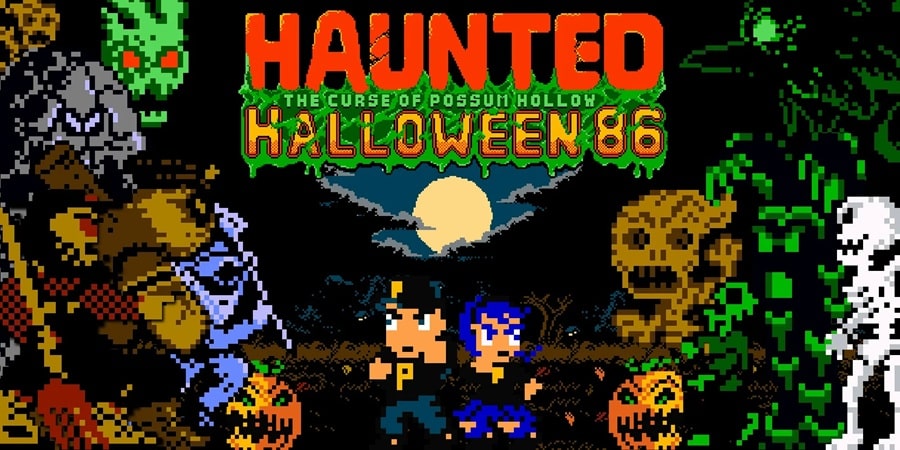 Haunted Halloween ’86
Haunted Halloween ’86
Call me naive, but I honestly believe this isn’t just a nostalgic cash grab. Retrotainment Games built Haunted: Halloween ’86 using authentic 6502 Assembly language, sticking to NES hardware specs. The game serves up modern mechanics like combo moves, upgradeable power-ups, and physics-based momentum. Add seven sprawling levels and some gnarly bosses, and you’ve got a treat worth trading all your Halloween candy for. Digital formats are coming this summer, with no specific release date announced as of now. But if you’re after the collectable cartridges those come directly from Spirit at their website and they literally sold out in a couple of hours. Restocks are coming, but no date on that yet either.
Looks like we all really love the retro experience.
COVER REVEAL: Only A Grave Will Do (Malitu trilogy #3) by James Llyod Dulin

Official Author WebsitePre-order Only A Grave Will Do over HEREAdd Only A Grave Will Do on Goodreads
Today we have super thrilled to be part of the cover reveal for the last book of the Malitu trilogy by James Lloyd Dulin,
Feast your eyes on the gorgeous cover for ONLY A GRAVE WILL DO by artist Martin Mottet, the book released on June 24th 2025 and you can checkout the blurb below:

OFFICIAL BLURB: On the march towards war, blood is both a promise and a gamble.
Newly dubbed the Hero of Anilace, Kaylo is thrust into leading a rebellion against insurmountable odds. His people are dying, if not in labor camps, in occupied cities as everything that makes them Ennean is stripped away. In two generations, the Great Spirits will be legends and Ennea will be yet another conquered territory. People look to Kaylo and the myth growing around him to stem the rising tide.
Sixteen years later, a trivial rebellion, a reclusive nation, and a vast empire march towards a battle to decide the fate of Ennea and her people. The actions of the small folk go unseen. Those who want to serve; those who have given up; those imprisoned; those who will fight at any cost; and those who will protect the people they love with every breath will tip the scales. Ennea is not done fighting.

Isn't it gorgeous?
There will also be a blog tour for the book release and you can check out all the details in the graphic below

Spotlight on Gourmet “Aftertaste” by Daria Lavelle
What if you could have one last meal with someone you’ve loved, someone you’ve lost?…
The post Spotlight on Gourmet “Aftertaste” by Daria Lavelle appeared first on LitStack.
On McPig's Wishlist - Illuminations
 Illuminationsby T. Kingfisher
Illuminationsby T. KingfisherRosa Mandolini knows in her heart that her family are the greatest painters of magical illuminations in the city. But the eccentric Studio Mandolini has fallen on hard times and the future is no longer certain.
While trying to help her family, Rosa discovers a strange magical box protected by a painted crow. But when she finds a way to open the box, she accidentally releases the Scarling, a vicious monster determined to destroy the Mandolini family at any cost.
With the aid of her former best friend and a painted crow named Payne, it’s up to Rosa to stop the Scarling before it unmakes the magical paintings that keep the city running, and hopefully save her family in the process!
Rapture
Emily Maguire’s new novel, Rapture, takes as its inspiration the legend of Pope Joan, reworking key elements of the myth to create a brilliant work of great power and beauty.
The story starts in 9th-century Mainz, Germany, where Agnes lives with her father, an English priest. Although his vows include celibacy, Agnes’s father has slept with a local Saxon woman, but her death in childbirth has left him with the responsibility of raising his daughter. Unusually for that time, Agnes is given an education, listening to the intellectual debates at her father’s dinner table. At one of these dinners, she meets Brother Randulf, a monk from Fulda Abbey, and thus begins their relationship. After her father’s untimely death, Randulf agrees to help Agnes disguise herself as a man to become a Benedictine monk. As Brother John, Agnes starts down the path that will lead her to becoming the head of the Roman Catholic church.
There is so much that is compelling about this novel. The writing is absolutely beautiful and often poetic in its intensity. Characterisation is intimate and believable, and Agnes’s perspective gives us a close insight into her views and feelings. The power of the novel lies in this range: Agnes is a person of huge intellect, but it is also her journey to womanhood, something that she initially represses, that becomes a key focus – with tragic consequences. The novel always bears its research lightly; we see the often-conflicted world of the monasteries, alongside the disintegration of the Carolingian dynasty after the death of Charlemagne and the terrible consequences of the ensuing civil war. Maguire depicts some horrific moments with artistic sensitivity and, as much as violence is a part of this world, its inclusion is never gratuitous.
This is a fabulous book for any serious reader of literary historical fiction. Very highly recommended.
The post Rapture appeared first on Historical Novel Society.
State of Emergency
Singapore, 1963. What can you say about a young woman, Siew Li, who walked away, without warning, from her twin children and husband? Jeremy Tiang says a lot as he weaves an always gripping and mostly grim story of people caught up in the long conflict between the forces of the right and left.
That the right won and steered Singapore through a rapid and rare transformation from third world to first is well-known. The story of the communist insurgence in Singapore and Malaysia has faded from public memory, despite works such as Anthony Burgess’s Malayan Trilogy and Yeng Pway Ngon’s Unrest. State of Emergency is a rich addition to this meagre literature.
Told from multiple viewpoints, linked stories connect small, human acts and place them against a larger narrative of ordinary people trapped in times when torture, murder, and massacre are condoned. From the opening scene, the historical MacDonald House bombing, to a fictional end in which Siew Li’s son gets as close to her as he ever will, this is a remarkable blend of the sweep of history and the minutiae of people’s lives.
There is a version of history which peddles the idea that the American invasion of Vietnam could have learned much from the more successful British-led intervention in Malaya. The survivors of Batang Kali (one of whom becomes a narrator for a while) would, of course, disagree. This novel gives them – and the dead – a voice.
I was left wanting to know much more about Siew Li than the author has revealed, even though she tells the story for some stints. There are surprising bloopers about the time zone in Thailand and a jungle being silent at night. On the balance, these are immaterial defects in this great work of historical fiction.
The post State of Emergency appeared first on Historical Novel Society.
Women in SF&F Month 2025: Thank You and Links
Thank you so very much to all of this year’s guests for the excellent essays that made April 2025 another amazing Women in SF&F Month! And thank you to everyone who shared their posts and helped spread the word about this year’s series. It is always very much appreciated! This year’s series has ended, but I wanted to make sure there was a way to find all of the guest posts from 2025. This was the fourteenth annual Women in […]
The post Women in SF&F Month 2025: Thank You and Links first appeared on Fantasy Cafe.7 Author Shoutouts | Authors We Love To Recommend
Here are 7 Author Shoutouts for this week. Find your favorite author or discover an…
The post 7 Author Shoutouts | Authors We Love To Recommend appeared first on LitStack.
Odd Old Indie: Night Tide
Growing up in Southern California in the 60’s and 70’s was a movie lover’s dream. Late night and weekend television in those days was almost completely given over to old movies, especially on the Los Angeles independent channels: KTLA channel 5, KHJ channel 9, KTTV channel 11, and KCOP channel 13.
The independent stations were especially prone to showing independent movies, small films that hadn’t cost much and hadn’t made much and could be acquired cheaply to occupy all the time that had to be filled until sign-off and the test pattern. Many of these movies were from the House of Corman (The Little Shop of Horrors, The Masque of the Red Death, Dementia 13), but most weren’t, and any night of the week you could watch a pulse-pounder like The Flesh Eaters, The Incredibly Strange Creatures Who Stopped Living and Became Mixed-Up Zombies, or Beast of Blood (once you had advanced — or descended — to Filipino horror movies you could consider yourself a schlock PHD.)
Most of these films were awful, of course (that’s how you wound up on channel 13 at two in the morning), but sometimes a (relative) diamond could be found among the ashes. One movie that I discovered during those years was Night Tide, an odd little indie that aimed a bit higher than the usual cheapie thriller. I was always happy when it popped up in the week’s TV Guide listings.
Made in 1960 and first screened in 1961, but not widely released until 1963 due to distribution confusion (it has a Corman connection after all, because it was released through Filmgroup, his distribution company) and directed by Curtis Harrington, it’s an offbeat film that has all of the expected deficiencies of a micro-budget independent movie along with some unexpected virtues. (It was supposedly made for $25,000, which wouldn’t even cover George Clooney’s carfare today.)
Clearly taking his inspiration from the series of nine horror films that Val Lewton produced for RKO in the 1940’s (Night Tide owes most to the first of them, 1942’s Cat People), Harrington (who wrote the script as well as directed) tells an ambiguous, poetic, melancholy story in an allusive, indirect way. Making a virtue of poverty, Harrington allows the viewer to fill in everything that is only suggested (because it would cost too much to show it), which was very much the strategy Lewton followed in making his underfinanced gems.
Night Tide is the story of a USN sailor, Johnny Drake (a twenty-five-year-old Dennis Hopper in his first lead role) and Mora (Linda Lawson), a young woman who appears as a mermaid in a boardwalk sideshow. (Most of the movie was shot just west of Los Angeles in Santa Monica.)
Strolling along a beachfront street one night, Johnny drops into a jazz club where he sees Mora sitting alone, raptly listening to the music. Struck by her dark beauty, Johnny asks if he can sit at her table to get a better view of the players. Mora agrees, but brushes aside the sailor’s attempts at conversation. While they are sitting there, a strange, black-clad, intense-looking woman comes up and speaks to Mora in a foreign language. The woman walks away, and Mora, visibly upset, rushes out of the club.
Johnny, desperate to make some kind of connection with this intriguing woman, follows Mora down the darkened street, all the while trying to persuade her to talk with him. Perhaps sensing a loneliness equal to her own and touched by his sincerity, Mora permits Johnny to walk her to her home above a carousel. She rebuffs his request to come upstairs with her, but she permits him to clumsily kiss her goodnight, and leaves him with an invitation to come back in the morning, when she will fix him breakfast.
When Johnny returns the next day, he first takes a look at the merry-go-round under Mora’s apartment, where he meets the ride’s operator and his granddaughter Ellen (Luana Anders), who both respond a little oddly when they hear that he’s there to visit the sideshow mermaid.
When Johnny goes upstairs, Mora greets him warmly and leads him through an apartment decorated with souvenirs of the sea, to a balcony overlooking the ocean, where they will have their breakfast. (Seafood, naturally.) During their conversation, the sailor and the enigmatic young woman shyly begin to get better acquainted.
Mora tells him about her job — “I wear an artificial fishtail and I lie in a tank that looks like it’s filled with water, and people pay twenty-five cents and come and look at me, and that’s how I make my living.” When Johnny asks her if she ever gets tired of it, she wistfully replies, “Sometimes — but it’s restful, anyway.”
When Mora asks Johnny to tell her something about his life, he tells her that he is alone in the world; his father left home when Johnny was just a boy, and when his mother died, he thought that the best way to get away from Denver, Colorado was to join the navy and see the world. “But I haven’t seen any of it yet.”
Then, as they are finishing their meal, an odd thing happens. A scavenging seagull swoops down on the table looking for scraps, and Mora takes it in her arms and gently strokes it and talks to it, and the wild creature seems perfectly calm and content. When Johnny asks her where she learned to do such a thing, Mora says that she doesn’t remember.
After their breakfast is done, they go down to the boardwalk and Johnny meets the man who owns the mermaid attraction and serves as its barker, Captain Samuel Murdock (Gavin Muir). He found Mora when she was a child on the Greek island of Mykonos, and brought the orphaned girl back to the United States as his ward. Murdock tells Johnny to drop by his house sometime; he will tell him some interesting things about his adoptive child.
Soon Johnny is spending every liberty with Mora, and even as they grow closer, the young sailor’s disquiet also grows, as he hears some strange things about his new girlfriend. Ellen (who is clearly attracted to Johnny) and others tell him that two young men who had grown close to Mora drowned in mysterious circumstances; the police are still investigating the deaths.
And one night on the beach, where people have gathered for a party, a curious thing occurs. A musician plays the bongo drums, and Mora begins to dance on the sand; as her movements grow wilder and more ecstatic, she looks toward the ocean and sees, standing silently there, watching her, the black-garbed woman who spoke to her in the jazz club. Johnny sees her too. Mora collapses in a swoon, and when Johnny rushes to her to see if she’s alright he looks around for the woman, but she is gone. The woman vanished n the few seconds it took him to get to Mora.
Increasingly worried, Johnny decides to visit Captain Murdock at his home in cement-canaled Venice, and as he nears the house, he sees the woman again. He pursues her, but she evades him in the maze of canals and bridges. When he arrives at the house, the captain gives him an effusive welcome, but soon adds to Johnny’s unease by telling him that he is in grave danger as long as he continues to see Mora, that the gentle-seeming girl might feel “compelled” to kill him. Before he passes out from drink, Murdock tells the disbelieving sailor that Mora is a siren, a member of the ancient race of sea people who lure men to their doom.
When Johnny tells Mora the captain’s story, she tells him that it’s true — “They are waiting for me to join them.” She believes that the strange woman who is following her is one of the sea people, “here to remind me of the time I must go to them in the sea.” Johnny’s scoffing at this absurd tale can neither shake Mora’s belief in her alien nature and her dark fate, or silence his own growing anxiety.
Visiting Mora after she finishes work one day, Johnny falls asleep on the couch while she takes a shower. He dreams that a towel-wrapped Mora walks out and sits by him on the couch, and looking down, he sees that her legs have turned into a fish’s tail; she is truly a mermaid, a creature not fully human. She leans over and begins to kiss him, and suddenly it is not the arms of a beautiful young woman that enfold him — he is entangled in the grotesque tentacles of a huge octopus, strangling him, devouring him. (This terrifying episode is probably Night Tide’s best-remembered scene.)
When Johnny awakens from this nightmare, he calls out to Mora but receives no answer. She has disappeared. Johnny follows her wet footprints out of the apartment and down to the beach. After frantically searching he finally finds her clinging to the pilings under the pier, barely holding on as she is battered by the waves of the incoming tide. As he carries her back to her apartment, she tells him that the sea people were calling her to them.
The next morning, Mora is strangely calm and later, after telling Johnny that the tides will be perfect (because the moon is full), she urges him to go diving with her at special place that she knows. (A few days earlier Johnny had visited a boardwalk Tarot reader who made ominous hints about his future due to the placement of the Moon card.) Johnny uneasily tries to convince Mora that a dive isn’t a good idea, but, unable to dampen her puzzling enthusiasm, he finally agrees.
Taking out a small boat, they make their dive (after Mora cautions the visibly nervous sailor to stay very close to her), and when they’ve gone down to the deepest point, Mora gets behind Johnny and cuts his air hose. As he desperately fights his way back to the surface, he looks back and sees Mora swimming away into the darkness. After waiting in the boat until long after her air would have run out, Johnny takes the boat to shore and stumbles back to Mora’s apartment, where he falls into an exhausted, troubled sleep.
There he has one last dream of this strange, ill-fated young woman — he sees her as a mermaid, sitting on the rocks with the waves crashing about her, an unreadable expression on her face as she regards herself in a mirror. When Mora turns and sees him, she slips into the churning water. Johnny reaches out and takes her hand, trying to pull her back up onto land, but he is not strong enough to overcome the immense power of the ocean’s pull, and a laughing Mora finally slips away from him and vanishes beneath the surface of the sea.
Later that rainy night, he wakes from this sleep, shaken and desolate, and walks to the boardwalk. Going into the mermaid exhibit, Johnny hesitantly looks into Mora’s tank, where he is stunned to see the body of the drowned girl floating face-up in the water, her hair streaming around her. She is still beautiful, even in death.
Captain Murdock (who found Mora’s body on the beach) emerges from the shadows with a gun in his hand and accuses Johnny of killing her, which the young man denies — “But I loved her.” “You loved her! What do you know about love?” Murdock replies. “I’ve loved her ever since she was a child. You did it and you must pay for it!” Murdock fires at Johnny but misses, and the shots bring the police, who take both men into custody.
At the police station a distraught Murdock makes a confession to a detective (and to Johnny — he asked that the sailor be present). When she was still a child, he began telling Mora that she was one of the sea people in the hope that it would keep her from forming close relationships with anyone else, and so prevent her from ever leaving him. Ultimately, even that didn’t keep Mora from wanting something more, and the captain killed her two boyfriends and made his ward believe that her inhuman nature was somehow responsible for their deaths; he just couldn’t bear the thought of losing the only person in the world he loved, the only person in the world who loved him.
Murdock’s “experiment in psychology” worked only too well; Mora “couldn’t face a recurrence of what had gone before, so rather than destroy the person she loved, she decided to embrace the rapture of the depths.”
The only thing left to clear up is the identity of the mysterious woman — was she an accomplice of Murdock, someone he had paid to follow Mora to remind her of her supposed evil destiny? The broken old man has never seen such a woman, never heard of her. She was part of no plan of his.
When Murdock is led out of the detective’s office, he gently pats Johnny on the shoulder, a sad little gesture between two men who will forever be linked by the loss of the woman they both immoderately loved.
The shore patrol arrives to take Johnny back to his ship, and Ellen is waiting at the desk to express her sympathy and to say goodbye. Maybe on his next liberty, Johnny can come by and take a ride on the carousel? The sailor smiles hesitantly and says that it seems like a good idea. As he walks out of the police station, the rain has ended, and a new day is dawning.
 Gavin Muir and Curtis Harrington
Gavin Muir and Curtis Harrington
The film closes with the lines from Poe’s “Annabel Lee” that gave it its title: “And so, all the night-tide, I lie down by the side / Of my darling — my darling — my life and my bride, / In her sepulchre there by the sea — / In her tomb by the surrounding sea.”
So, what do we have here? Is Night Tide a brilliant achievement, a neglected masterpiece? You can judge for yourself (there’s a very nice print on YouTube, though there wasn’t several years ago when I bought my Kino Lorber Blu-ray), but it’s not necessary to go quite that far.
You don’t have to look very hard to find Night Tide’s defects. The story, as I said before (and as Harrington always acknowledged) borrows heavily from Cat People, which is a better, more original film, and even if you’re not familiar with the earlier movie, it’s not too difficult to see where the story is going (Captain Murdock’s big revelation isn’t much of a surprise); the dialogue is sometimes stilted, both in the writing and in the delivery by the actors, some of the supporting playing is erratic, and the mark of the low budget is visually evident in dozens of ways.
But many of these failings have a positive aspect, too. If you’re going to pick a model, Cat People is a strong one, and many of its virtues are evident in its successor, while the low budget compelled Harrington to stick to the commonplace in costumes and sets, giving the movie a much-needed grounding in everyday reality (while also permitting the director to concentrate on character rather than on special effects). Despite a few overtly arty touches, the black-and-white cinematography (much of which was shot at night), strongly conveys the darkness and moody ambiguity of the story. (The film’s flute-heavy jazz score by David Raskin is both a plus and a minus; sometimes it’s delicate, eerie, and just about perfect, while at other times it’s discordantly, distractingly obtrusive.)
Perhaps the film’s greatest assets are Dennis Hopper and Linda Lawson. Both were experienced television actors in 1960, but Night Tide was the first movie lead for both of them, and the awkwardness and uncertainty that are sometimes detectable in their performances actually suit their characters very well. Hopper is convincingly shy and callow (a “fair young man, innocent and searching” as the Tarot reader calls him); his yearning for human contact comes across as touchingly genuine. (At the beginning of the movie, Johnny has some pictures taken in an automated photo booth; he puts his hat on, takes it off, smiles, looks serious… and then tucks the pictures into his pocket and walks away. He has no one to give them to.)
Linda Lawson, despite not being gifted with a very expressive voice, nicely coveys a loneliness and a consciousness of being separated from “normal” people that matches Johnny’s intense desire to connect with someone; she makes the lost, doomed Mora a moving, tragic figure.
Night Tide uses its limited resources to try for something different than the usual rubber-monster-on-the-loose quickie; it’s a mood piece in which feeling and atmosphere are more important than plot, a poetic, offbeat combination of fantasy and horror and mystery, wrapped around an ill-starred, very human love story. In some ways it’s almost an amateur film, but it’s none the worse for that. (Remember that one meaning of amateur is someone who does something just for the love of it.) The movie has a unique flavor, sweet and sad, and for all of its (understandable and forgivable) deficiencies, it lingers in the mind; it gets under your skin.
You can always recognize a film that was truly important to the people who made it, and Night Tide is one of those; clearly, it wasn’t just another job to Curtis Harrington, Dennis Hopper, Linda Lawson, and the rest of the people who worked on it — it meant something to them. If you give it a chance — say late some lonely night — you might find that this old, odd little movie has come to mean something to you, too.
Thomas Parker is a native Southern Californian and a lifelong science fiction, fantasy, and mystery fan. When not corrupting the next generation as a fourth grade teacher, he collects Roger Corman movies, Silver Age comic books, Ace doubles, and despairing looks from his wife. His last article for us was The Eccentric’s Bookshelf: Michael Weldon’s Psychotronic Encyclopedia of Film
The Baby Dragon Café - Book Review by Voodoo Bride
 The Baby Dragon Café (The Baby Dragon #1)by A.T. Qureshi
The Baby Dragon Café (The Baby Dragon #1)by A.T. QureshiWhat is it about:When Saphira opened up her café for baby dragons and their humans, she wasn’t expecting it to be so difficult to keep the fires burning. It turns out, young dragons are not the best magical animals to keep in a café, and replacing all that burnt furniture is costing Saphira more than she can afford from selling dragon-roasted coffee.
Aiden is a local gardener, and local heart-throb, more interested in his plants than actually spending time with his disobedient baby dragon. When Aiden walks into Saphira’s café, he has a genius idea – he'll ask Saphira to train his baby dragon, and he'll pay her enough to keep the café afloat.
Saphira’s happy-go-lucky attitude doesn’t seem to do anything but irritate the grumpy-but-gorgeous Aiden, except that everywhere she goes, she finds him there. But can this dragon café owner turn her fortunes around, and maybe find love along the way?
What did Voodoo Bride think of it:This could have been more than it was.
Don't get me wrong:I liked the romance. Once again it was grumpy/sunshine, and I really liked the grumpy Aiden. He's more of an introvert than actually grumpy, I have to say. I totally read this book start to finish to see him get the girl and happiness.
It was the world building and the dragons that didn't vibe for me. I felt like the author didn't really know if the dragons were pets or beings that had similar intelligence as humans. The baby dragons felt really off because of that. I also thought the café wasn't used enough in the story. It was more a starting point than something the book revolved around.
The writing style was nice enough, but didn't draw me in. I was not bored enough to stop reading, and not entertained enough to glue myself to the book.
All in all a nice enough read, but I won't be reading other books in this series/world.
Why should you read it:Grumpy, introverted gardener.
Book Review: When the Wolf Comes Home by Nat Cassidy
I received a review copy from the publisher. This does not affect the contents of my review and all opinions are my own.
 When the Wolf Comes Home by Nat Cassidy
When the Wolf Comes Home by Nat Cassidy
Mogsy’s Rating: 4.5 of 5 stars
Genre: Horror
Series: Stand Alone
Publisher: Tor Nightfire (April 22, 2025)
Length: 304 pages
Author Information: Website
I have to admit, the first time I read Nat Cassidy with Nestlings, my feelings were mixed. But boy, am I glad I gave his work another chance, because When the Wolf Comes Home was a trip that went straight for the jugular. It’s horror that masks itself as a traditional werewolf tale, but what you’ll find instead is a raw and emotionally charged story that goes much deeper than that.
Plot-wise, the story follows a young Los Angeles woman named Jessa Bailey who has reached a dead-end in her acting career and is currently trying to make ends meet by working at a dingy diner. After experiencing a traumatic health scare, she makes her way back home feeling anxious and dazed, only to have her night turned upside down a second time when she discovers a terrified little boy hiding in the bushes outside her apartment. After getting him inside and squared away some clothes and food, she gets his story—or most of it, anyway, before they are attacked by a monster. The beast, which looks half man and half wolf, proceeds to tear through the building and kill many of its residents, and Jess and her new charge only barely manage to escape.
It soon becomes clear that the monster is hunting the boy, but that’s not all that’s coming after them. Certain elements in the government are also interested in getting their hands on him, and a Special Agent named Michael Santos has been tasked to track him down on behalf of a secret organization. Jess has no idea why so many people are desperate to find the boy, but the longer she spends with him, the more she realizes he’s special. Strange and uncanny things seem to happen around him, which Jess finds disturbing and hard to believe. However, once she is named as a person of interest in the attack on her apartment, their fates become intertwined. With no one else to turn to, Jess becomes the boy’s protector and his only chance of survival.
When the Wolf Comes Home is the kind of novel that would translate well to the big screen, with cinematic writing that moves at a fast clip and a story with plenty of action and just the right amount of emotional resonance. But while a film adaptation of this book would undoubtedly be a horror movie, simply because of all the gore and terror, I also think it would be a lot more complicated. As the plot progresses, the surface peels back to reveal several layers of meaning. Our protagonist Jess is deeply flawed and unsure of herself, still feeling raw from the pain of losing her estranged father whom she’s never forgiven for abandoning her. The story’s themes hit hard when you realize the monster chasing her is more than a creature of folklore.
There’s also a surreal quality here that I wasn’t sure what to make of, initially. There were certainly scenes that bordered on sheer absurdity, and I confess, when the first of these scenes hit, my regard for the novel dropped considerably. But this was before I realized how integral these moments were to the big picture. Without spoiling anything, these distortions to reality are directly related to the mystery surrounding the boy and the ideas underpinning the entire story. I couldn’t possibly hold the surrealism against the book after that and even started to enjoy these moments when they added a spot of humor to an otherwise bleak premise.
And truly, most of this book is dark. Sometimes it gets too dark, and you wonder how much more our characters can afford to lose and still manage to keep their hope and sanity. There’s a heaviness that borders on exhausting, and so perhaps it is not surprising that my main complaint lies in the ending. At times, when I’m feeling generous, I think to myself that there’s no other way things could have played out. But when I’m in a more critical mood, I feel like the pacing was all wrong. If nothing else, the novel probably should have ended soon after the climax and not have such a long denouement.
Still, When the Wolf Comes Home is a fantastic read, and a standout in horror fiction. In fact, it easily ranks as one of the most memorable horror novels I’ve read in recent years. When you pick up the book, look at its cover and read its title, you’d be forgiven for thinking this is just another werewolf story. I know that’s what I thought at first. But instead, what Nat Cassidy has delivered here is entirely his own: a wild and weird blend of tension, chills, and heartbreak. It simply works.
![]()
![]()
Swordfights, Mysteries, and Dark Sorcery: Solomon Kane: The Serpent Ring #1 by Patrick Zircher

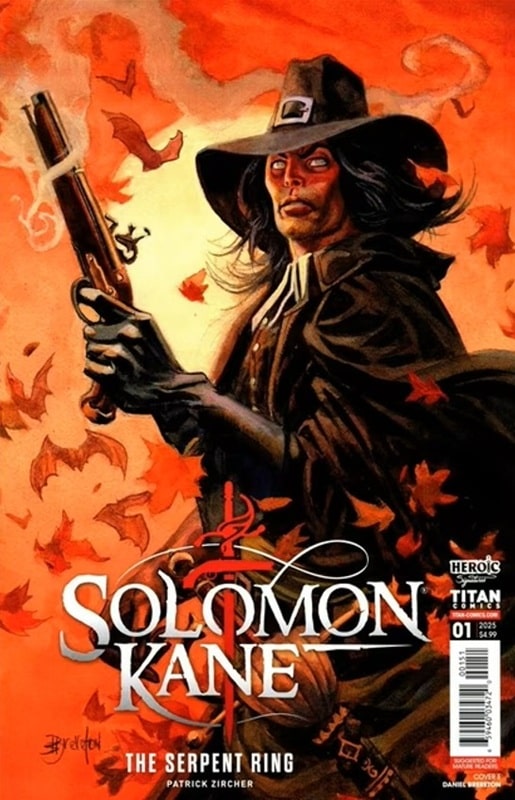
Solomon Kane: The Serpent Ring #1, and variant cover by Daniel Brereton (Titan Comics, March 26, 2025)
Sometimes a project and a creator are brought together in the right place at the right time. Titan Comics’ Solomon Kane mini series The Serpent Ring is one of those times. Writer/Artist Patrick Zircher is working at the very top of his game. The project is dear to his heart, and it shows.
The first issue begins, fittingly enough, in Africa. This would have pleased Kane’s creator Robert E. Howard, because some of REH’s best Kane tales, “The Footfalls Within,” “The Hills of the Dead,” “Wings in the Night,” etc, take place on that continent.
[Click the images to ring in bigger versions.]
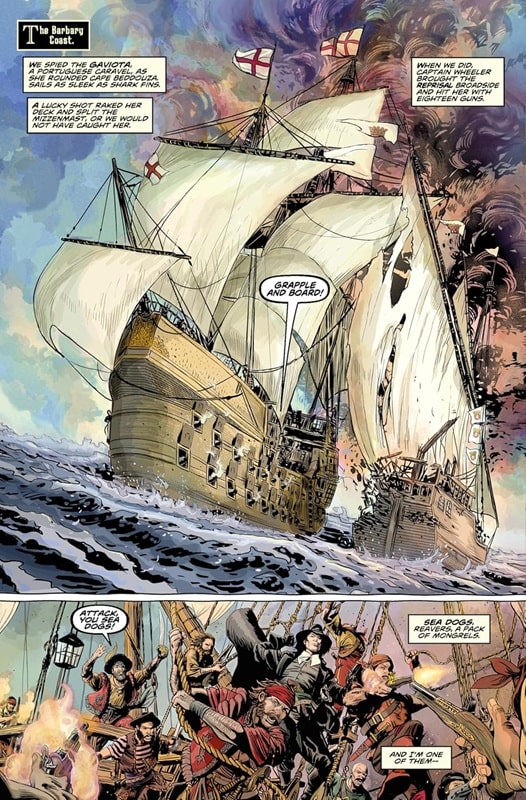
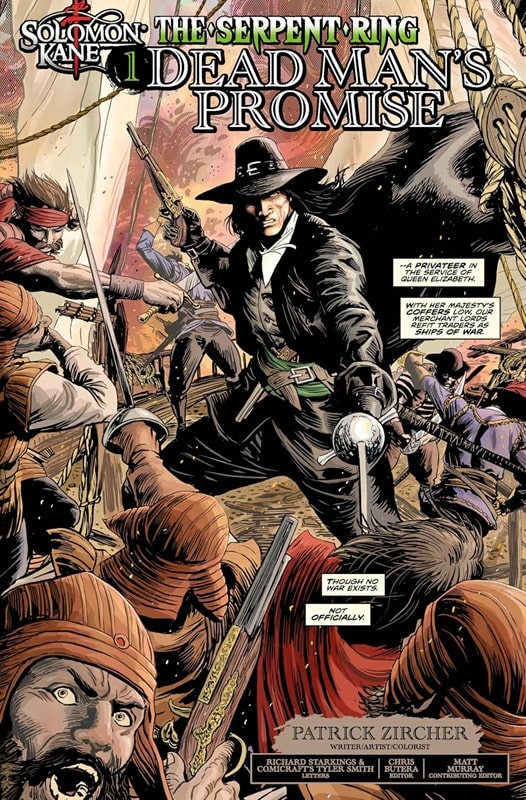
Interior art for Solomon Kane: The Serpent Ring #1 by Patrick Zircher
The first few pages of the comic are a prologue introducing some mysterious characters and incidents. We pick up with Solomon Kane three pages later, serving with a band of Queen Elizabeth’s privateers. Kane and his companions are in a pitched battle with the crew of a Spanish ship.
In an unfortunate occurrence Kane kills a passenger, ‘an innocent man,’ and makes a promise to the dying man to atone for his mistake. This sets the main plot in motion and Kane’s quest will take him from the Barbary Coast to Italy. On the way there will be swordfights, pistol battles, mysteries added to mysteries, and intimations of dark sorcery.
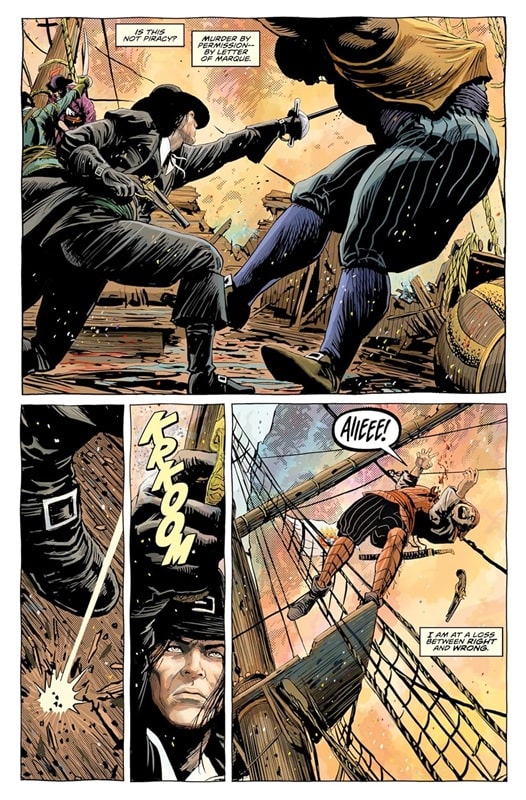
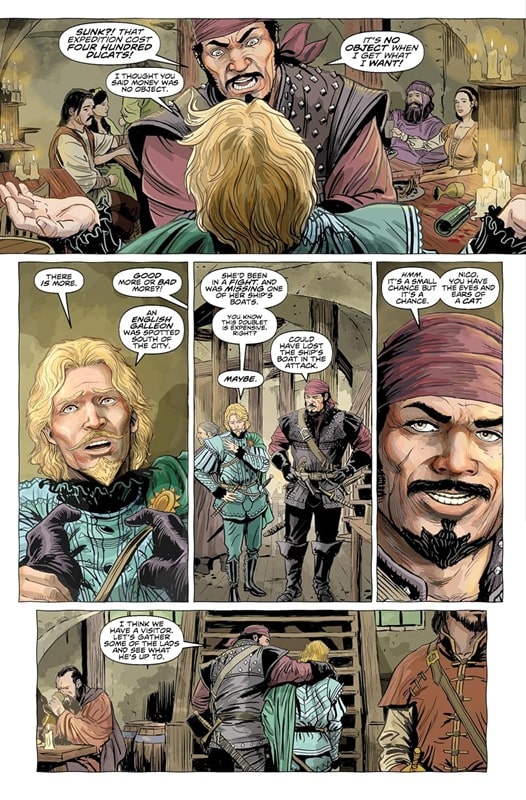
More interior art for Solomon Kane: The Serpent Ring #1 by Patrick Zircher
That’s all the plot I’ll give away, because you should read it for yourself, so let me talk a bit instead about Patrick Zircher’s work on the comic. Having spoken to Patrick online a good bit, I know this is one of his favorite comics he’s ever worked on. He’s a huge fan of Solomon Kane and it really comes through on the pages.
The story has an epic feel as it ranges around Europe, and a large cast of characters. All of that is well researched and beautifully illustrated, be it sailing ships or the streets of Napoli and Venice. Period costumes, weapons, and people are all extremely well done.

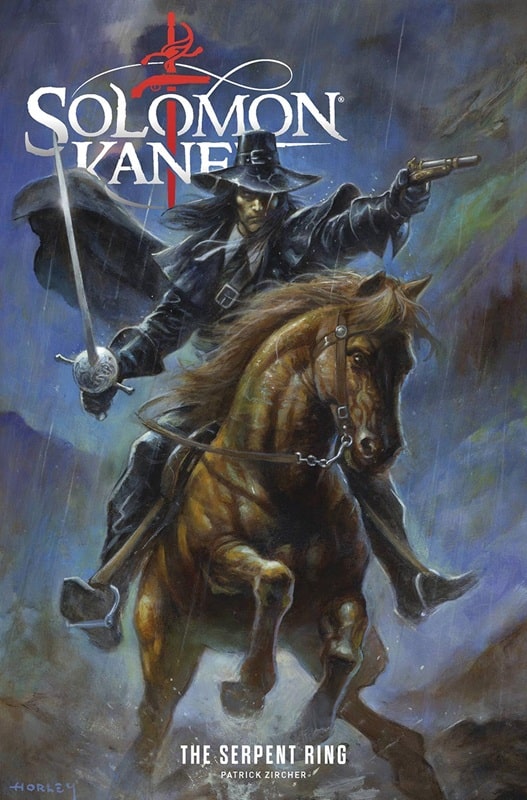
Issues #2 and #3 of Solomon Kane: The Serpent Ring. Covers by Rafael Kayanan and Alex Horley
For the Robert E. Howard fan this is prime stuff, Solomon Kane drawn and written by someone who loves the character and the world. It’s very much in the spirit of Howard’s work. I asked Patrick for a quote about his feelings working on the book and he said:
Solomon Kane embodies, in one character, what I love in stories. Action, adventure, suspense, horror, heroism, and wrestling with the ‘big questions’ of life.
Can’t ask for more than that.
Charles R. Rutledge lives in Atlanta, Georgia. This is his first article for Black Gate.
Women in SF&F Month: International Giveaway
I’m giving away one book of the winner’s choice for Women in SF&F Month today! Since there were some US-only giveaways earlier this month, this giveaway is for everyone else (though there are a few caveats given international shipping). Here’s how it works: You can choose your own adventure from the books/authors featured this month available on Kennys Bookshop, and I will ship the winner the book of their choice. This giveaway is open to anyone on the list of […]
The post Women in SF&F Month: International Giveaway first appeared on Fantasy Cafe.
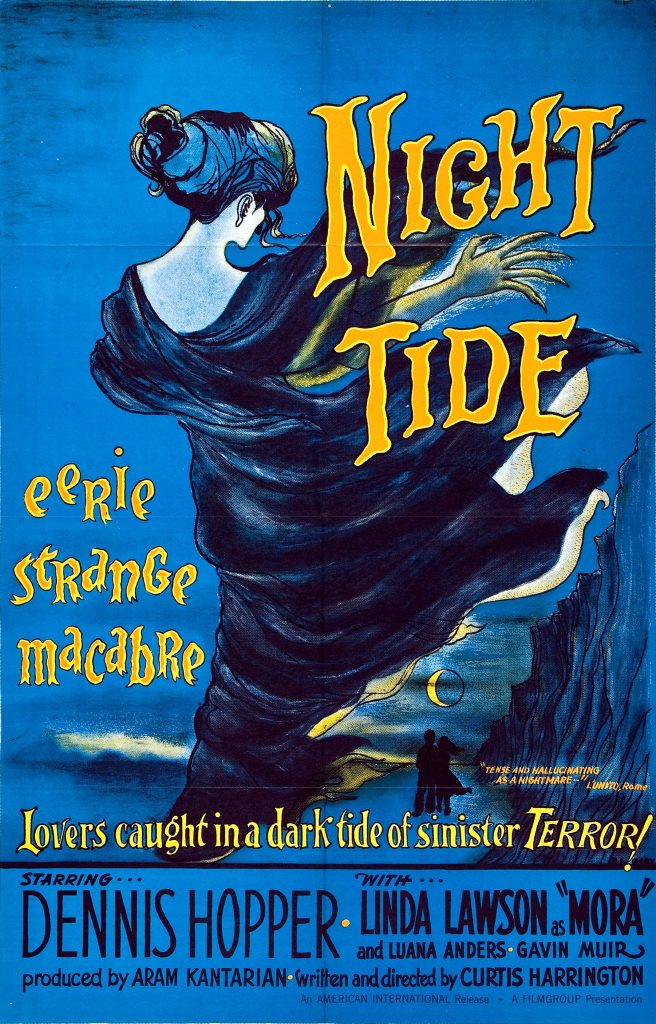


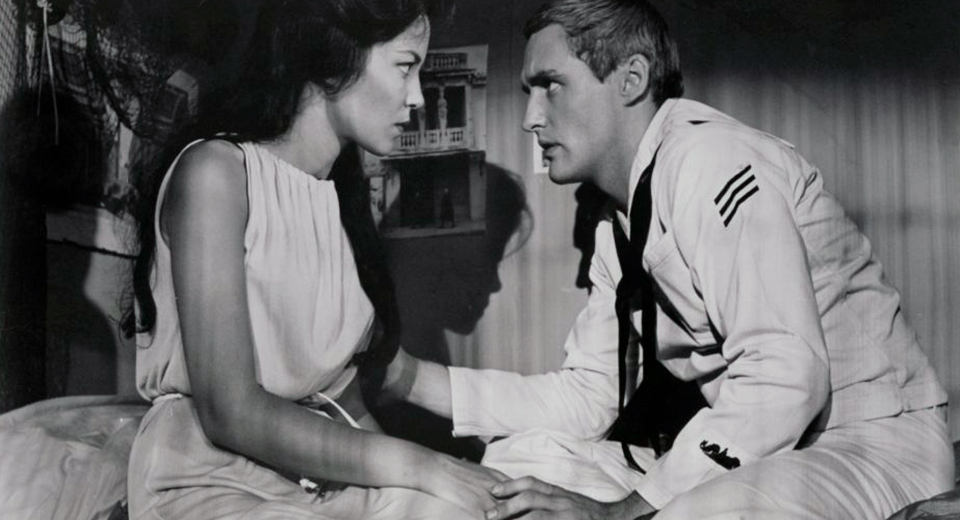
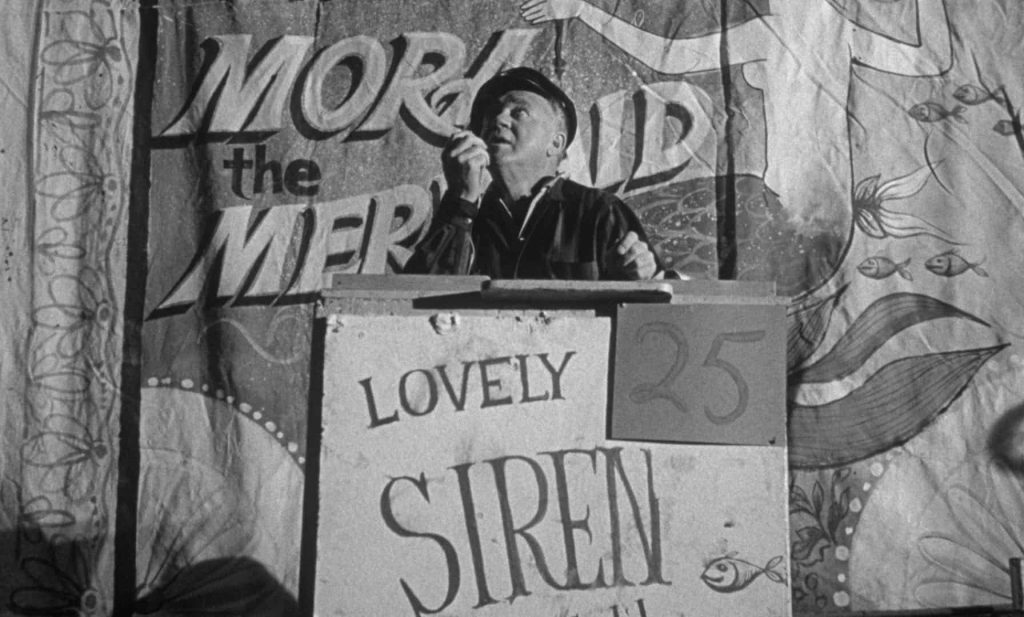

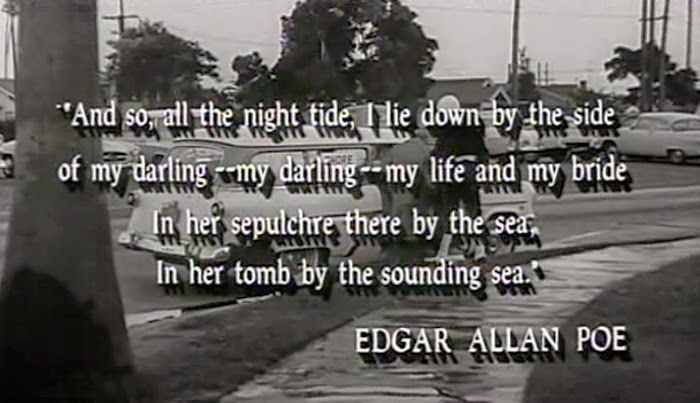
Recent comments